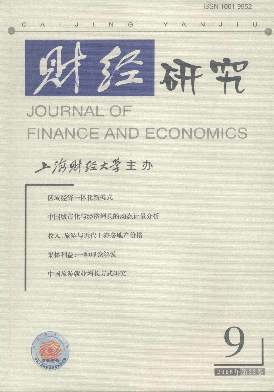国防支出与经济增长关系的战略选择——一个数理模型的分析与模拟
财经研究 2006 年 第 32 卷第 09 期, 页码:80 - 92
摘要
参考文献
摘要
国防支出与经济增长之间的关系到底如何、怎样安排国防支出才能有利于国防和经济建设,这是国防经济学必须回答的基本问题。文章在一系列假设前提下,构建了一个简单的数学模型,描述了经济总量制约国防支出、国防支出又反作用于经济增长的内在机理,并通过数字模拟比较了三种国防支出战略对于经济增长和国防资本积累的不同影响,对现实中的很多问题给予了解释,得出了一些有意义的结论。
[1]基斯.哈特利,托德.桑德勒(姜鲁鸣等译).国防经济学手册[M].北京:经济科学出版社,2001.
[2]杜为公.西方国防经济学研究[M].北京:军事科学出版社,2005.
[3]李双杰,陈渤.Feder-Ram模型及对中国国防支出与经济增长相关性的实证分析和应用[J].数量经济技术经济研究,2002,(8):90~93.
[4]陈波.国防支出与经济增长:中国的经验研究(1985~2000),卢周来.中国国防经济学:2004[M].北京:经济科学出版社,2005.
[5]胡鞍钢,刘涛雄.中国国防建设大大滞后于经济建设:从国防资本存量占全国总量比重看国防能力变化[R].第四届中国经济学年会参会论文,2000.
[6]Thilo Klein.Military expenditure and economic growth:Peru 1970~1996[J].Defenceand Peace Economics,2004,15(3):275~288.
[7]Macnair,Elizabeth S,Murdoch,James C.Growth and defense:Pooled estimates for theNATO alliance,1951~1988[J].Southern Economic Journal,1995,61(3):846.
[8]Reitschuler,Gerhard,Loening,Josef L.Modeling the defense-growth nexus in guate-mala[J].World Development,2005,33(3):513~526.
[9]Chung-Nang Lai,Bwo-Nung Huang,Chin-Wei Yang.Defense spending and economicgrowth across the Taiwan straits:A threshold regression model[J].Defence&PeaceEconomics,2005,16(1):45~57.
[10]Crespo Cuaresma,Jesús and Reitschuler,Gerhard.A non-linear defence-growth nexus?evi-dence from the US economy[J].Defence&Peace Economics,2004,15(1):71~82.
[11]Dritsakis N.Defense spending and economic growth:an empirical investigation forGreece and Turkey[J].Journal of Policy Modeling,2004,26(2):249~264.
①见Benoit E.,1973,Defense and economic growth in developing countries(LexingtonBooks,Lexingtong,MA)。
②见Benoit E.,1978,Growth and defense in developing countries,Economic Developmentand Cultural Change 26,271~280。
③参阅基斯.哈特利、托德.桑德勒主编,姜鲁鸣等译,《国防经济学手册》,第250~252页。
④关于这一研究的近期进展,见Reitschuler和Loening(2005)、Chung-Nang Lai,et.(2005)、Crespo Cuaresma,and Reitschuler(2004)、Dritsakis,N(2004)等。
⑤同③,见第276~284页。参考文献[2]。
[2]杜为公.西方国防经济学研究[M].北京:军事科学出版社,2005.
[3]李双杰,陈渤.Feder-Ram模型及对中国国防支出与经济增长相关性的实证分析和应用[J].数量经济技术经济研究,2002,(8):90~93.
[4]陈波.国防支出与经济增长:中国的经验研究(1985~2000),卢周来.中国国防经济学:2004[M].北京:经济科学出版社,2005.
[5]胡鞍钢,刘涛雄.中国国防建设大大滞后于经济建设:从国防资本存量占全国总量比重看国防能力变化[R].第四届中国经济学年会参会论文,2000.
[6]Thilo Klein.Military expenditure and economic growth:Peru 1970~1996[J].Defenceand Peace Economics,2004,15(3):275~288.
[7]Macnair,Elizabeth S,Murdoch,James C.Growth and defense:Pooled estimates for theNATO alliance,1951~1988[J].Southern Economic Journal,1995,61(3):846.
[8]Reitschuler,Gerhard,Loening,Josef L.Modeling the defense-growth nexus in guate-mala[J].World Development,2005,33(3):513~526.
[9]Chung-Nang Lai,Bwo-Nung Huang,Chin-Wei Yang.Defense spending and economicgrowth across the Taiwan straits:A threshold regression model[J].Defence&PeaceEconomics,2005,16(1):45~57.
[10]Crespo Cuaresma,Jesús and Reitschuler,Gerhard.A non-linear defence-growth nexus?evi-dence from the US economy[J].Defence&Peace Economics,2004,15(1):71~82.
[11]Dritsakis N.Defense spending and economic growth:an empirical investigation forGreece and Turkey[J].Journal of Policy Modeling,2004,26(2):249~264.
①见Benoit E.,1973,Defense and economic growth in developing countries(LexingtonBooks,Lexingtong,MA)。
②见Benoit E.,1978,Growth and defense in developing countries,Economic Developmentand Cultural Change 26,271~280。
③参阅基斯.哈特利、托德.桑德勒主编,姜鲁鸣等译,《国防经济学手册》,第250~252页。
④关于这一研究的近期进展,见Reitschuler和Loening(2005)、Chung-Nang Lai,et.(2005)、Crespo Cuaresma,and Reitschuler(2004)、Dritsakis,N(2004)等。
⑤同③,见第276~284页。参考文献[2]。
引用本文
严剑峰. 国防支出与经济增长关系的战略选择——一个数理模型的分析与模拟[J]. 财经研究, 2006, 32(9): 80–92.
导出参考文献,格式为:
上一篇:集体利益:一种理论解说





 7252
7252  8207
8207

